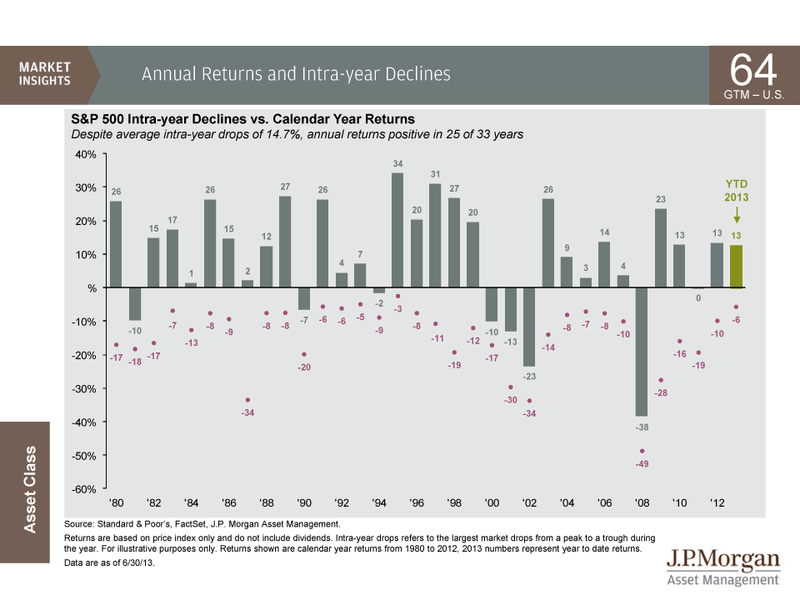What is the most important decision for the long-term investor?
This is actually an easy question, but most investors get it wrong. You need to choose the right level of risk!
Here are the key facts:
- Even in the best market years there is often a serious "correction" during the year. Since 1980, the average intra-year decline has been 14.5%. Every time there is a modest pullback you will see many warnings that this is the "big one." That is when most investors bail out.
- And of course there really are a few big ones.
Here is the helpful table via JP Morgan's Guide to the Markets:
The last couple of years have had unusually low intra-year declines. This might be giving a false impression.
Most investors are far too confident of their risk tolerance. I question new clients carefully on this front. If you are going to have a portfolio that is 100% in stocks, no matter how diversified, you must be prepared to weather a 20% decline. I ask clients to pick a number that would be an acceptable "paper" loss – and we all hate losses, even on paper. If our own first-rate indicators said that it was a "psychological" correction, not supported by fundamentals, what number would be tolerable. Take that number and multiply by 5. That tells you how much you can invest in stocks.
This approach works much better than some of the questionnaires used by various firms who are just touching the bases on compliance. I am trying to learn what people really think!
Most investors over-estimate their risk tolerance, take on positions that are too large, and then wind up selling whenever there is a correction. Their poor market timing is why they trail a buy-and-hold program by 5% or more. The major reason for a bond portfolio is to reduce the overall volatility.
It is better to have an acceptably sized risk and stay in the market than to be too big and get scared out.
Every investor should start by considering risk, not return!
You should not try to be a poker-playing genius, going "all-in" or all out based upon some index, omen, or advice from a guru on TV. You need a low-volatility anchor for your portfolio. Traditionally, this has been the role of bonds.
The problem is that bond mutual funds are now too dangerous – likely losers as interest rates move higher.
Possible Solutions
In past postsI have covered this topic in some detail. Let us focus today on three possible solutions. (I continue to explore others).
- A bond ladder. This allows you to get the interest rate you expect and principal on maturity. You can then roll out to the higher rates. The exit strategy is built into the program, unlike a bond mutual fund. You might only make 3% or so, but you can adjust to rising rates and it provides a conservative anchor to your portfolio, allowing you to step out with the rest.
- Reasonable dividend stocks. I say "reasonable" because the quest for yield has driven some dividend plays into territory that is too rich for me. I do not like utilities, but I do favor some of the established companies with great balance sheets and dividends in the 3% range.
- Selling calls against your dividend stocks. An actively managed portfolio, focused on selling the rapidly-decaying short term calls, can dramatically increase the return from a dividend stock portfolio. This is a good plan for those who are not seeking gangbuster market returns. It is safer and more dependable in a sideways market. It is a good blend for those who have a bond ladder and some stocks. I target 9% (after costs) but agile individual investors might match this or do better. You need a low cost broker.
There are other nominees under review. There are MLP's, but the tax issues dissuade many. There are alternative funds. There are structured products. Some of these ideas are very good and might be attractive for the average investor. The problem is the complexity and potential for a fatal mistake.
More to come on these ideas.
Conclusion and Anecdotes
The importance of right-sizing risk remains. The loss of bond funds as a solid portfolio anchor creates a new challenge.
I talk with many investors each week, both existing clients and those who might become part of our group. A recent case featured someone whose account had cratered during the 2008 decline. She now wanted to make it back in a short time, and asked me for a schedule of projected gains. This very smart person was focused on return, not on risk, despite her few remaining years until retirement. I'm not sure what the others promised, but creating false expectations is not wise.
Many others are very nervous. They read the headlines, which always sell fear (covered in this post where I explain how to quantify actual risks).
My basic solution is one that you can imitate. The Enhanced Yield approach serves as a bond substitute, reducing portfolio volatility while delivering 9% or so after commissions. It will do this in a sideways market, and it also has a lot less risk than a stock fund in a declining market. Examples of stocks that you could use if you want to try this at home are CSCO, INTC, MSFT (old tech works well), KSS (surprising retail strength), and DE. The key is valuation, a reasonable dividend, and picking a call that is out of the money and will return 10% annualized from the sale. Do not chase if the conditions are not right.
Whatever you choose as an anchor, do not be over-confident about stocks. If you are young and willing to ignore volatility, the prospects are good. For most people, the risk/reward balance is crucial.
[Long all named stocks versus short calls]
